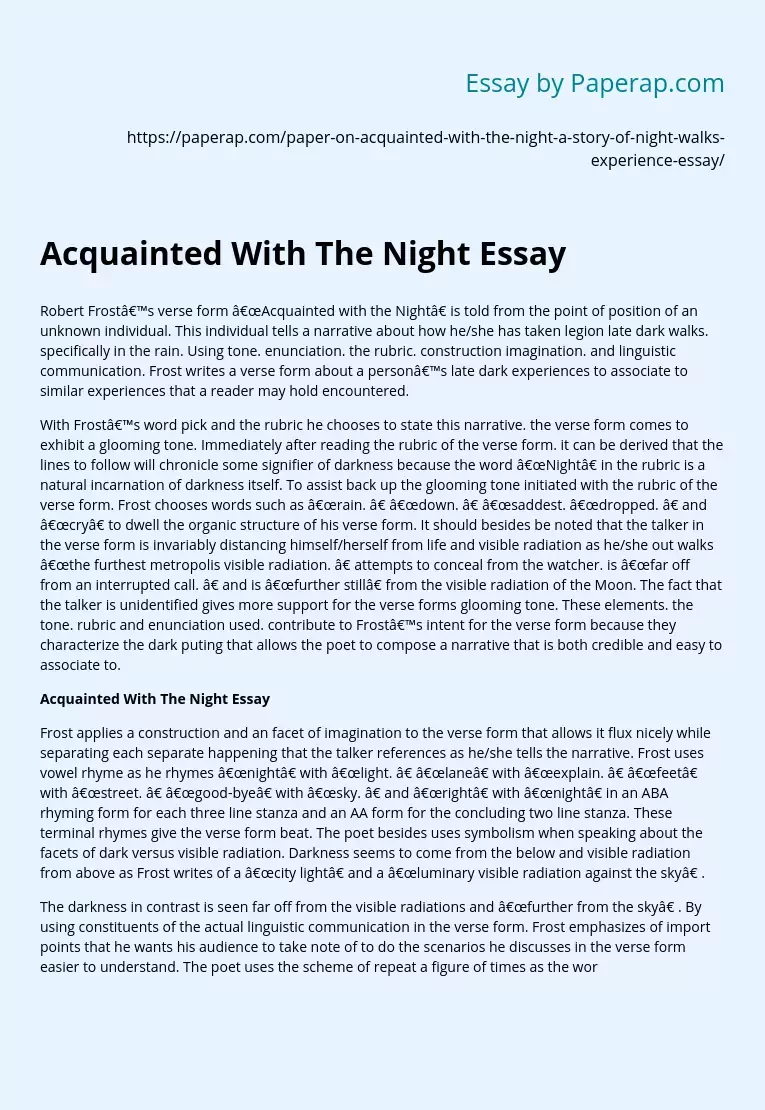Acquainted With The Night Essay
Robert Frost’s verse form “Acquainted with the Night” is told from the point of position of an unknown individual. This individual tells a narrative about how he/she has taken legion late dark walks. specifically in the rain. Using tone. enunciation. the rubric. construction imagination. and linguistic communication. Frost writes a verse form about a person’s late dark experiences to associate to similar experiences that a reader may hold encountered.
With Frost’s word pick and the rubric he chooses to state this narrative.
the verse form comes to exhibit a glooming tone. Immediately after reading the rubric of the verse form. it can be derived that the lines to follow will chronicle some signifier of darkness because the word “Night” in the rubric is a natural incarnation of darkness itself. To assist back up the glooming tone initiated with the rubric of the verse form. Frost chooses words such as “rain. ” “down. ” “saddest. “dropped. ” and “cry” to dwell the organic structure of his verse form.
It should besides be noted that the talker in the verse form is invariably distancing himself/herself from life and visible radiation as he/she out walks “the furthest metropolis visible radiation. ” attempts to conceal from the watcher. is “far off from an interrupted call. ” and is “further still” from the visible radiation of the Moon. The fact that the talker is unidentified gives more support for the verse forms glooming tone. These elements. the tone. rubric and enunciation used. contribute to Frost’s intent for the verse form because they characterize the dark puting that allows the poet to compose a narrative that is both credible and easy to associate to.
Acquainted With The Night Essay
Frost applies a construction and an facet of imagination to the verse form that allows it flux nicely while separating each separate happening that the talker references as he/she tells the narrative. Frost uses vowel rhyme as he rhymes “night” with “light. ” “lane” with “explain. ” “feet” with “street. ” “good-bye” with “sky. ” and “right” with “night” in an ABA rhyming form for each three line stanza and an AA form for the concluding two line stanza. These terminal rhymes give the verse form beat. The poet besides uses symbolism when speaking about the facets of dark versus visible radiation. Darkness seems to come from the below and visible radiation from above as Frost writes of a “city light” and a “luminary visible radiation against the sky” .
The darkness in contrast is seen far off from the visible radiations and “further from the sky” . By using constituents of the actual linguistic communication in the verse form. Frost emphasizes of import points that he wants his audience to take note of to do the scenarios he discusses in the verse form easier to understand. The poet uses the scheme of repeat a figure of times as the words “I have” get down all three lines of the first stanza. the first two lines of the 2nd stanza. the first line of the 2nd stanza. disappears from the 4th stanza. and reappears in the 5th stanza and the last line of the verse form. Frost does this to foreground that the talker of the verse form is familiar with the dark of the dark.
In add-on. the phrase “acquainted with the night” is. including the rubric. repeated three times in the verse form to underscore the fact the talker is so rather familiar with the scenarios that he/she is depicting. Through tone. enunciation. the rubric. construction. imagination. and linguistic communication. Robert Frost tells the narrative of how and why the talker has become “acquainted with the night” with the intent of associating what takes topographic point in the verse form to similar ordeals that a reader may hold experienced. The poet makes the tone of the verse form dark and gloomy so that the words the talker says incorporate a more baleful and powerful weight to them. This helps to do the verse form feel like an escapade.
Acquainted With The Night Essay. (2019, Dec 05). Retrieved from https://paperap.com/paper-on-acquainted-with-the-night-a-story-of-night-walks-experience-essay/

